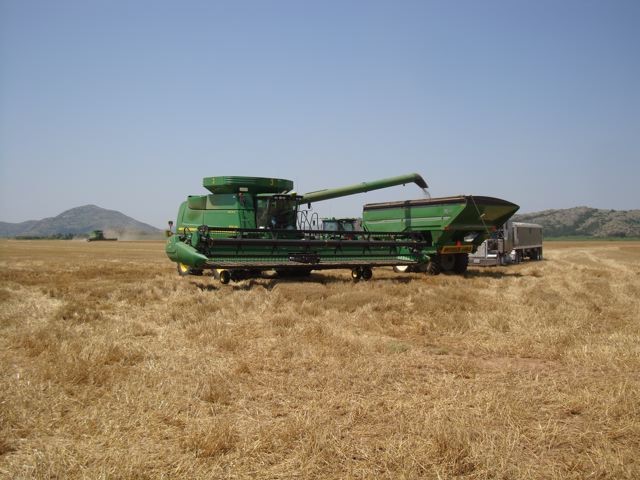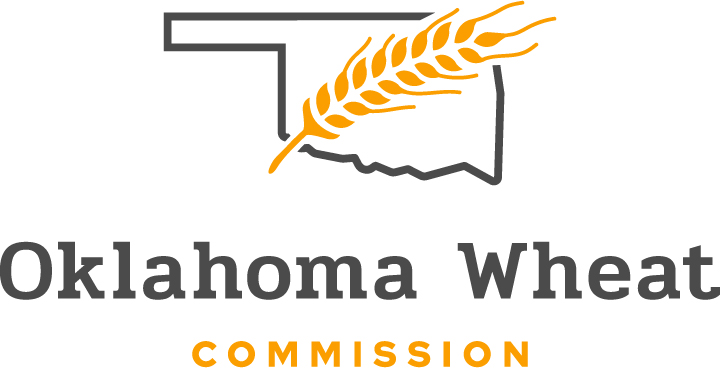
Agricultural News
Winter Wheat Crop Gets Slightly Bigger- Oklahoma Estimate of 128.7 Million Bushels From June Left Unchanged
Fri, 09 Jul 2010 8:09:31 CDT
 The latest USDA reports are out- including Crop Production as of July first (this includes the latest Winter Wheat Crop Production Estimates) as well as the monthly Supply Demand Numbers that come from the ERS. We have some audio comments that Tom Leffler gave to our own Ed Richards right after the release of the report this morning. Click on the LISTEN BAR at the very bottom of this page for those comments about what Leffler sees in today's numbers.
The latest USDA reports are out- including Crop Production as of July first (this includes the latest Winter Wheat Crop Production Estimates) as well as the monthly Supply Demand Numbers that come from the ERS. We have some audio comments that Tom Leffler gave to our own Ed Richards right after the release of the report this morning. Click on the LISTEN BAR at the very bottom of this page for those comments about what Leffler sees in today's numbers.
The Crop Production show a winter wheat crop that is getting bigger as harvest moves north. "Winter wheat production is forecast at 1.51 billion bushels, up 2 percent from last month but down 1 percent from 2009. The United States yield is forecast at 46.9 bushels per acre, up 0.3 bushel from last month and up 2.7 bushels from last year. If realized, this will be tied for the third highest yield on record, trailing only 1999 and 2008. The area expected to be harvested for grain totals 32.1 million acres, unchanged from the Acreage report released on June 30, 2010 but down 7 percent from last year.
"Hard Red Winter, at 1.01 billion bushels, is up 3 percent from a month ago. Soft Red Winter, at 268 million bushels, is down 6 percent from the previous forecast. White Winter is up 3 percent from last month and now totals 226 million bushels. Of this total, 17.8 million bushels are Hard White and 208 million bushels are Soft White."
The Oklahoma winter wheat crop estimate was unchanged from the June numbers released by USDA- NASS believes that there will be a total of 3.9 million bushels of wheat harvested in Oklahoma at an average of 33 bushels per acre for a total of 128.7 million bushels being produced here in 2010. The Oklahoma Crop is 67% larger than the 2009 crop that totalled just 77 million bushels.
Kansas yields are better than were predicted back in June- as Uncle Sam raised average bushels per acre for Kansas from 42 bushels per acre up to 45 bushels per acre- making the Kansas crop almost even with a year ago at 369 million bushels, based on July first data.
The Texas crop was edged up about two million bushels from the June forecast- and is now projected as 124.5 million bushel crop in 2010- based on 3.55 million acres to be harvested, yielding 35 bushels per acre.
Click here for the full Crop Production report for July 9, 2010 from USDA.
**************************************************************
The monthly Supply Demand Report from USDA says the larger wheat crop will help push ending stocks for the new marketing year to a 23 year high- despite a prediction of a good export season. "Exports are projected 100 million bushels higher with lower expected production in several major exporting countries and strong early season export sales. Despite increased foreign demand for U.S. wheat, ending stocks for 2010/11 are projected 102 million bushels higher and remain at an expected 23-year high."
Click here for the full report from the ERS on Supply Demand data as of July 9, 2010.
Some of the other highlights from the report:
Course Grains (or Feed Grains)
Projected U.S. feed grain supplies for 2010/11 are lowered with reduced carryin and lower projected production. Beginning stocks for corn are projected 125 million bushels lower reflecting higher use in 2009/10. With forecast harvested area down, corn production is lowered 125 million bushels, leaving supplies down 250 million bushels and 60 million below the 2009/10 record. Exports for 2010/11 are projected 50 million bushels lower as tighter domestic supplies, strong demand from ethanol production, and rising prices reduce the export competitiveness of U.S. corn. Ending stocks for 2010/11 are projected down 200 million bushels at 1,373 million, 105 million below the 2009/10 projection. The season-average farm price for corn is projected 15 cents higher on both ends of the range to $3.45 to $4.05 per bushel.
Oilseeds
U.S. oilseed production for 2010/11 is projected at 100.8 million tons, up 1.7 million tons from last month, with increased soybean production accounting for most of the change. Soybean production is projected at 3.345 billion bushels, up 35 million due to increased harvested area. Harvested area is estimated at a record 78 million acres in the June 30 Acreage report, 0.9 million above the June projection. The soybean yield is projected at 42.9 bushels per acre, unchanged from last month. Increased exports and crush offset increased supplies, leaving projected 2010/11 ending stocks at 360 million bushels, unchanged from last month. Higher soybean exports reflect increased import projections for China for 2010/11.
The U.S. season-average soybean price for 2010/11 is projected at $8.10 to $9.60 per bushel, up 10 cents on both ends of the range. Soybean meal prices are projected at $240 to $280 per short ton, up 10 dollars on both ends. Soybean oil prices are projected at 34 to 38 cents per pound, unchanged from last month.
Cotton
The U.S. 2010/11 cotton projections include higher production, domestic mill use, exports, and ending stocks compared with last month. Production of 18.3 million bales is raised nearly 10 percent from the June estimate due to higher planted area, as reported in the June 30 Acreage report, combined with lower expected abandonment and a higher average yield per harvested acre. The projected abandonment rate and yield have been adjusted to reflect early July crop conditions in the Southwest, which are the most favorable since 1994/95. Domestic mill use is raised marginally on stronger recent activity. Exports are raised sharply due to the projected larger available supply and strong foreign demand. While ending stocks of 3.5 million bales are 700,000 bales above last month, the stocks-to-use ratio of 20 percent remains relatively tight. The projected range for the marketing-year average price received by producers is unchanged at 60 to 74 cents per pound.
Livestock and Poultry
Total U.S. meat production forecasts for 2010 and 2011 are adjusted slightly. Cow slaughter remains relatively high boosting beef production in 2010. Higher forecast mid-year cattle placements are also expected to boost steer and heifer slaughter later in the year and into early 2011. Pork production is forecast higher for 2010 based on increased slaughter and heavier dressed weights; mainly during the second quarter. The June 1 Quarterly Hogs and Pigs report indicated that producers intend to have fewer sows farrow in the second half of 2010. Although largely offset by gains in pigs per litter, year-over growth in sows farrowing in 2011 is slower than previously forecast, and the 2011 pork production forecast is reduced slightly. Broiler production is forecast higher for 2010 and 2011. Hatchery data point toward continued growth in bird numbers and weights have been moving up. Turkey and egg production forecasts are unchanged from last month.
A slight increase is made to beef exports for 2010. Broiler exports for 2010 and 2011 are raised due to stronger shipments to a number of small markets and a resumption in exports to Russia.
Cattle and hog price forecasts for 2010 are reduced from last month as demand remains relatively weak in the face of higher production. The 2010 broiler price is adjusted to reflect second quarter prices. Prices for 2011 are unchanged. The turkey price forecasts for 2010 and 2011 are raised from last month in the face of continued tight supplies. The egg price forecasts are lowered for 2010 and 2011.
WebReadyTM Powered by WireReady® NSI
Top Agricultural News
More Headlines...




















